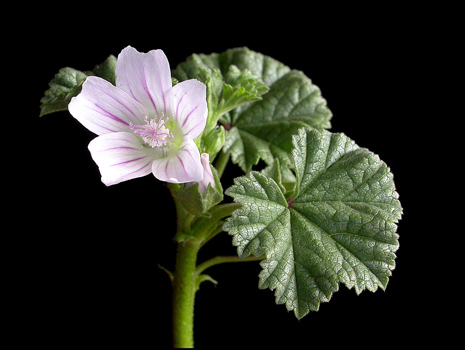|

|
A
Close-up View of the Wildflower
"Common Mallow"
(Malva neglecta)
by Brian Johnston (Canada)
|
The common mallow is ubiquitous in most
of North America. Its pinkish-white flowers are distinguished by
radial darker pink lines, and might be mistaken for hollyhock blooms,
but for their much smaller size. The stems that form the creeper
may grow as long as half a metre, and are punctuated by many round,
scallop-edged leaves. These leaves are very soft to the touch and
it is hypothesized that the names "mallow" and "Malva" may have
originated from the Greek "malache" which means "soft". The
species name "neglecta"
is derived from the Greek "neglectus" meaning "not chosen". This
probably referred to the fact that the plant was not gathered for food.
The image below shows a prominently veined common mallow leaf.
Notice how closely the leaves of this plant resemble those of the
geranium.
A bud about to unfurl its petals is shown below. Notice that the
green sepals are half the length of the flower's petals.
Common mallow blooms have five petals, notched at the tips, and a
diameter of 1.5 to 2 centimetres.
A side view reveals the horn-shaped appearance of the bloom.
The two images below show the column of white, pollen encrusted stamens
that surrounds the pinkish multi-lobed style.
Common mallow pollen is perfectly spherical, and covered with tiny very
sharp spikes. Under the microscope, both normal transmitted, and
dark-field illumination resolve the detail.
The problem of severely reduced depth of field at high magnification is
evident in the two images below. Focus has been adjusted in order
to show the spikes on the front surface, and at the edge of a grain.
Once flowers have dried up, and the petals have fallen off, the ovaries
develop into the fruits shown below. Notice that the sepals
remain in a ring around each disk. The right hand fruit still has
the shrivelled brown remnants of the petals attached. Because of
the fruit's resemblance to a tiny round cheese wheel, common mallow is
often referred to by the name "cheeses". As a child, I can
remember picking these seed-pods and eating them. They had a
crispy texture and distinctive taste. (Since the area where I
obtained these samples had recently been treated with weed-killer, I
thought it best not to re-experience the taste!)
A closer view shows the structure more clearly. The fruit is
composed of up to twenty wedge-shaped segments, in a flat button-shaped
disk called a schizocarp.
Each segment constitutes one of the seeds. (The pink dot visible
at the centre of the disk is the connection point of the pistil.)
The mucilaginous root of another family member, the marsh mallow plant,
used to be gathered to produce the well known "Marshmallows" that we still consume
today. Now, however, the marsh mallow roots have been replaced by
gum arabic or gelatin in the manufacturing process.
Like many other wildflowers, common mallow is often considered a
nuisance weed by home-owners. It tends to spread rapidly,
covering large areas of lawn if given the chance. In the "wild"
however, this plant adds a small, but beautiful bit of colour to the
landscape.
Photographic Equipment
The low magnification photographs
in the article were taken using a Nikon Coolpix 4500 with a combination
of natural light and the Nikon Cool light SL-1. Higher
magnification images were taken with natural light using a Sony
CyberShot DSC-F 717 equipped with a combination of achromatic close-up
lenses (Nikon 5T, 6T and shorter focal length achromat) which screw
into the 58 mm filter threads of the camera lens. (These produce
a magnification of from 0.5X to 9X for a 4x6 inch image.) Still
higher magnifications were obtained by using a macro coupler (which has
two male threads) to attach a reversed 50 mm focal length f 1.4 Olympus
SLR lens to the F 717. (The magnification here is about 13X for a
4x6 inch image.) The photomicrographs were taken with a Leitz SM-Pol
microscope (using a dark ground condenser), and the Coolpix 4500.
©
Microscopy UK or their contributors.
Published in the May
2008 edition of Micscape.
Please report any Web problems or
offer general comments to the Micscape
Editor.
Micscape is the on-line monthly magazine
of the Microscopy UK web
site at Microscopy-UK
©
Onview.net Ltd, Microscopy-UK, and all contributors 1996 onwards. All
rights reserved. Main site is at www.microscopy-uk.org.uk
with full mirror at www.microscopy-uk.net .










